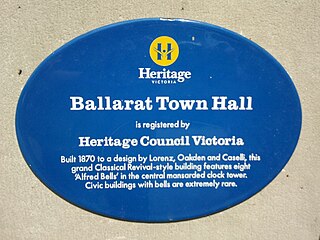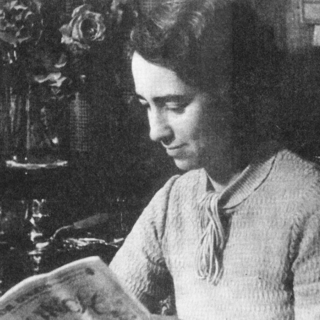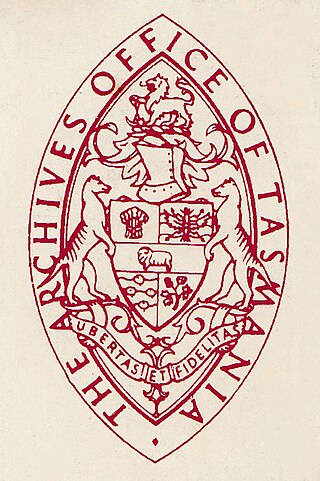History
Prior to 1903 there was no formal attempt to deposit Victorian government records with an archival authority. In that year ten volumes of Convict Indents were transferred to the Public Library (later the State Library of Victoria) by the Secretary of the Law Department. In 1928 following a board of Inquiry into 'Methods in the Public Service,' a circular was issued conveying the Premier's Instruction that no documents were to be destroyed without reference to the Public Library Trustees. [3] The first archivist was appointed to the staff of the Public Library in 1948. In 1955 a Senior Archivist was appointed and a separate Archives Section was established in 1961. The Library Council of Victoria Act 1965 introduced the first, though brief, legislative provisions for the control and preservation of public records in Victoria.
The Public Records Act came into effect on 17 April 1973. The Laverton Base Repository was acquired in 1975 and developed to ultimately house approximately 80 kilometres of public records and to provide a facility for public research. The holdings, based on the records transferred from the Archives Division of the State Library of Victoria, grew through an active transfer program. A reading room in the Melbourne CBD was established and a regional repository to serve the Victorian Central Highlands Region was established at Ballarat in 1982.
The purpose built Victorian Archives Centre (VAC) was designed and constructed in North Melbourne and all Melbourne based activities of PROV were transferred there, including the complete holdings from the Laverton Base Repository, by 2004. The VAC reading room is named after the first Keeper of Public Records, Harry Nunn OAM, [4] and is a facility shared by PROV with the Melbourne Office of National Archives of Australia. Researchers can thus access archives of both the Victorian and Australian governments in the one reading room. The VAC repository has a potential capacity of over 120 kilometres of shelf space.
Senior Archivists and Keepers of Public Records
- 1948 Donald Baker, first Archivist at the Public Library of Victoria [5]
- 1949 Rosemary McGowan, Archivist [5]
- 1951 Patricia Ingham, Archivist [5]
- 1955 Harry Nunn, Senior Archivist [5]
- 1973 Harry Nunn, Keeper of Public Records [5]
- 1981 Chris Hurley, Keeper of Public Records [5]
- 1990 Loretta Hambly, Keeper of Public Records [5]
- 1992 Ross Gibbs, Keeper of Public Records
- 2004 Justine Heazlewood, Keeper of Public Records
Structure
The Public Records Act established the Public Record Office, the position of Keeper of Public Records and the Public Records Advisory Council. Subject to the general control and direction of the Minister responsible for the Public Record Office, the Keeper exercises the powers and responsibilities defined in the Act. The role of the Advisory Council is, in consultation with the Keeper, to promote cooperation between PROV and public offices and to report or make recommendations to the Minister.
The Office's structure reflects the two broad areas of responsibility defined in the Act, that is, a role in providing leadership and services in records management for Victorian public offices, and the preservation of and provision of access to the State's archives.
The Keeper of Public Records is able to establish standards for the management [6] of public records and a large proportion of the Office's resources are dedicated to meeting obligations in this area. Of particular significance is the pioneering Victorian Electronic Records Strategy (VERS).
The Victorian Electronic Records Strategy (VERS) is a standard that addresses the problem of capturing, managing and preserving electronic records. [7] The standard is set by the Public Record Office Victoria (PROV).
The other main arm of the Office is dedicated to preservation and access. Access to public records is both by traditional delivery of original records to individual researchers in PROV reading rooms and through innovative physical and online publications, exhibitions, public programs, databases and reproductions of public records.
A number of approved places of deposit have been established throughout the state under the Public Records Act. [8]

The Public Record Office, Chancery Lane in the City of London, was the guardian of the national archives of the United Kingdom from 1838 until 2003, when it was merged with the Historical Manuscripts Commission to form The National Archives, based in Kew. It was under the control of the Master of the Rolls, a senior judge. The Public Record Office still exists as a legal entity, as the enabling legislation has not been modified.

State Library Victoria (SLV) is the state library of Victoria, Australia. Located in Melbourne, it was established in 1854 as the Melbourne Public Library, making it Australia's oldest public library and one of the first free libraries in the world. It is also Australia's busiest public library and, as of 2023, the third busiest library globally.

The West Gate Freeway is a major freeway in Melbourne, the busiest urban freeway and the busiest road in Australia, carrying upwards of 200,000 vehicles per day. It links Geelong and Melbourne's western suburbs to central Melbourne and beyond. It is also a link between Melbourne and the west and linking industrial and residential areas west of the Yarra River with the city and port areas. The West Gate Bridge is a part of the freeway.

The National Archives of Australia (NAA), formerly known as the Commonwealth Archives Office and Australian Archives, is an Australian Government agency that is the official repository for all federal government documents. It collects, preserves and provides public access to these documents, as well as other archival material related to Australia that the Archives judge ought to be preserved.
Records management, also known as records and information management, is an organizational function devoted to the management of information in an organization throughout its life cycle, from the time of creation or receipt to its eventual disposition. This includes identifying, classifying, storing, securing, retrieving, tracking and destroying or permanently preserving records. The ISO 15489-1: 2001 standard defines records management as "[the] field of management responsible for the efficient and systematic control of the creation, receipt, maintenance, use and disposition of records, including the processes for capturing and maintaining evidence of and information about business activities and transactions in the form of records".

The Old Treasury Building on Spring Street in Melbourne was built in 1858-62 in the grand Renaissance Revival style. It was designed to accommodate the Treasury Department, various government officials' offices including the Governor In Council, and basement vaults intended to house gold from the Victorian gold rush. It now houses a range of functions, including a museum of Melbourne history, known as Old Treasury Building Museum.

Victoria is a state in southeastern Australia. It is the second-smallest state, with a land area of 227,444 km2 (87,817 sq mi); the second-most-populated state, with a population of over 6.7 million; and the most densely populated state in Australia. Victoria is bordered by New South Wales to the north and South Australia to the west and is bounded by the Bass Strait to the south, the Great Australian Bight portion of the Southern Ocean to the southwest, and the Tasman Sea to the southeast. The state encompasses a range of climates and geographical features from its temperate coastal and central regions to the Victorian Alps in the northeast and the semi-arid northwest.

Heritage Victoria is a branch of the Victorian Department of Transport and Planning. It is the regulator responsible for administering the Heritage Act 2017. The Heritage Act provides for the protection and conservation of the cultural heritage of Victoria and establishes the Victorian Heritage Register and Heritage Inventory. The Register is a list of places and objects which are of significance to the State of Victoria. The Inventory is a list of known historical archaeological sites. Both statutory lists can be searched via the Victorian Heritage Database.
The NSW State Archives Collection archives and manages the records of the history of the Government of New South Wales in Australia, and is a part of Museums of History NSW. Prior to 2022, it was a standalone authority known as the State Archives and Records Authority of New South Wales. It can trace its history back to the establishment of the office of Colonial Secretary and Registrar of the Records of New South Wales in 1821. However, in the early years of the Colony's history, little attention was paid to the management and preservation of non-current public records. This was mainly because the government of the day was fully focussed on the administration of the convict system, law and order, immigration and land settlement. Documents which were not required for the day-to-day running of the government were usually neglected or were destroyed.
The Victorian Community History Awards are held annually to recognise the contributions made by Victorians in the preservation of the State's history, and to recognise excellence in historical research. The effect of the VCHA over the period from 1998 to the present has been the stimulation of community history, the lifting of standards and the fostering of diversity and originality.
This article highlights the timeline of the establishment of the State Records Authority of New South Wales.
The Queensland State Archives is the lead agency for public recordkeeping in Queensland, Australia. It is the custodian of the largest and most significant documentary heritage collection about Queensland.

The M80 Ring Road is a partially complete urban freeway ring road around Melbourne, Australia. This article will deal with the entire length of the corridor for sake of completion, as well to avoid confusion between declarations.
The Surveyor-General of Victoria is the public service officer nominally responsible for government surveying in Victoria, Australia. The original duties for the Surveyor-General were to measure and determine land grants for settlers in Victoria.. The Surveyor-General continues to be the primary government authority on surveying and the cadastre.
The Central Road Board was the first dedicated body for administering the construction of roads and bridges in Victoria, Australia. It came into being in 1853 when the Victorian Legislative Council passed An Act for making, and improving Roads in the Colony of Victoria, known as the Roads Act.

Phyllis Mander-Jones was an Australian born librarian and archivist who helped establish the archival profession in Australia.
Heidelberg Historical Society is a museum and research organisation devoted to the local and community history of Heidelberg and surrounding areas in the north-eastern suburbs of Melbourne, Victoria, Australia.

Thea Melvie Exley was an Australian archivist and art historian, and the first woman to head a regional office of the Australian Commonwealth Archives Office. She was also its first national Senior Archivist Reference and Access and the first Director Preservation at the Australian Archives. Exley was an inaugural member of the Australian Society of Archivists and served as a Councillor from 1977 to 1979.

The Archives Office of Tasmania (AOT), 1965-Ongoing is the Tasmanian government agency responsible for the archival records of the State of Tasmania. The Archives Act 1965 established the Archives Office of Tasmania as an independent entity, but it remained within the then Tasmanian State Library Department.











